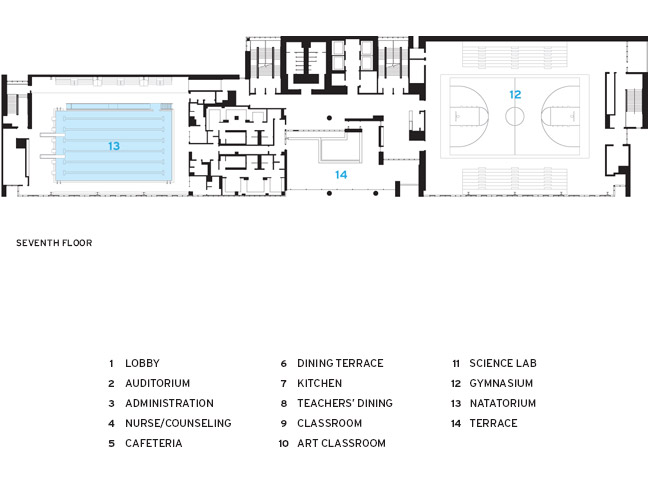William Jones College Preparatory High School
Perkins+Will stacks a dense program into a school building that rivals its lofty downtown-Chicago neighbors.




























Architects & Firms
Chicago
Picture this: in the shadow of Chicago’s famously tall downtown, a public school for 1,200 students now stands to rival the towers around it. In certain ways, William Jones College Preparatory High School is like any typical new urban school: big, glassy, flexible, and colorful. But the similarities pretty much end there. As opposed to sprawled-out high schools built on enough horizontal real estate to provide space and parking for all, Jones College Prep is stacked on its site in Chicago’s South Loop neighborhood. There’s even an underground garage beneath the building. “It’s an interesting example for the future, particularly as cities densify,” says the school’s lead architect, Ralph Johnson, global design director of Perkins+Will. “People are now living downtown.”
The 278,000-square-foot school just about doubles the capacity of an existing facility located on the north end of the same block. Built in 1967 as Jones Commercial High School to train students to be secretarial and office workers, the main structure of that old campus—also designed by Perkins+Will—is a slit-windowed, six-story building. The school switched to an academic program in 1982, then a college-preparatory curriculum in 1998—and has since been named one of America’s Best High Schools for four straight years by U.S. News & World Report. However, the building, which was originally programmed like an office complex, is still in use, and there are plans to restore the Modernist concrete structure and then link it to its larger sibling.
The new Jones is taller, broader, and more complex than its predecessor. The site, previously occupied by a parking lot and the city’s historic Pacific Garden Mission (since relocated), is relatively small for a high school. And the Printer’s Row neighborhood, which is listed on the National Register of Historic Places, abuts the site’s western edge. So there was no place to build but up. “Most schools are horizontally communicating,” Johnson says. “This one communicates vertically, which was a key strategy.”
In addition to classrooms and offices, the school, which has selective enrollment, required long spans for large spaces that would typically go on a ground floor, such as its 475-seat auditorium, a gymnasium, and a competition-size swimming pool. According to Perkins+Will senior project architect Bryan Schabel, the challenge was arranging the big parts, the heights and weights, so that the overall design made sense structurally and economically.
The lobby, administrative area, and auditorium’s main floor take up most of the school’s first story. The auditorium, on the north end, has a balcony and a fly space, which gives it greater height. “Everything else in the building has to line up,” notes Schabel. To balance the auditorium’s height, the architect stacked a cafeteria and media center on the second and third floors of the building’s south side. They configured long bands of classrooms, laboratories, and other instructional areas on the fourth and fifth floors, and placed the natatorium above them on the south end of the building, so that the pool’s great weight is efficiently transferred downward through the classroom space beneath. The gym, which is at the opposite end of the hall on the school’s north side, weighs less than the pool. “So it went over the auditorium and has a large transfer truss,” says Schabel.
Together, the architects and PBC are seeking LEED Gold certification for the building, which has a green roof and a system that collects rain and releases it slowly into the city’s stormwater system. Other sustainable measures include LED lighting and occupancy sensors.
Rather than hide the design and structural choices behind a monolithic facade, Johnson chose to express them. The exterior reads horizontally where long classroom bays are located, whereas terraces and reading gardens appear as recesses and voids, giving the facade depth. Acknowledging its historic neighbors, the south and west facades, which face Printers Row, feature terra-cotta-colored precast concrete panels to match the red-brick exteriors of nearby buildings. “We really wanted this building to be part of the fabric of the city,” says Johnson.
People
Owner:
Architect:
Personnel in architect's firm who should receive special credit:
Managing Principal:
Technical Principal:
Senior Project Designer:
Project Managers:
Senior Project Architect:
Senior Technical Coordinator:
Educational Planner:
Sustainable Leader:
Project Team:
Architect of Record:
Associate architect(s):
Interior designer:
Engineers:
MEP Engineer:
Civil Engineer:
Consultant(s):
Theater:
Acoustical:
Natatorium:
Food Service:
General contractor:
Photographer(s): Size: 278,000 square feet Cost: $114.6 million (total); $90.9 million (construction) Completion date: August 2013 |
Products
Structural system
Exterior cladding
Metal Panels:
Precast concrete:
Moisture barrier:
Curtain wall:
Roofing
Green Roof:
Glazing
Doors
Metal doors:
Fire-control doors, security grilles:
Hardware
Closers:
Exit devices:
Pulls:
Security devices:
Interior finishes
Suspension grid:
Cabinetwork and custom woodwork:
Paints and stains:
Plastic laminate:
Solid surfacing:
Special surfacing:
Floor and wall tile:
Resilient flooring:
Carpet:
Special interior finishes unique to this project:
Furnishings
Lighting
Downlights:
Task lighting:
Exterior:
Conveyance
Plumbing
Water Cooler:
Shower Controls: |

















